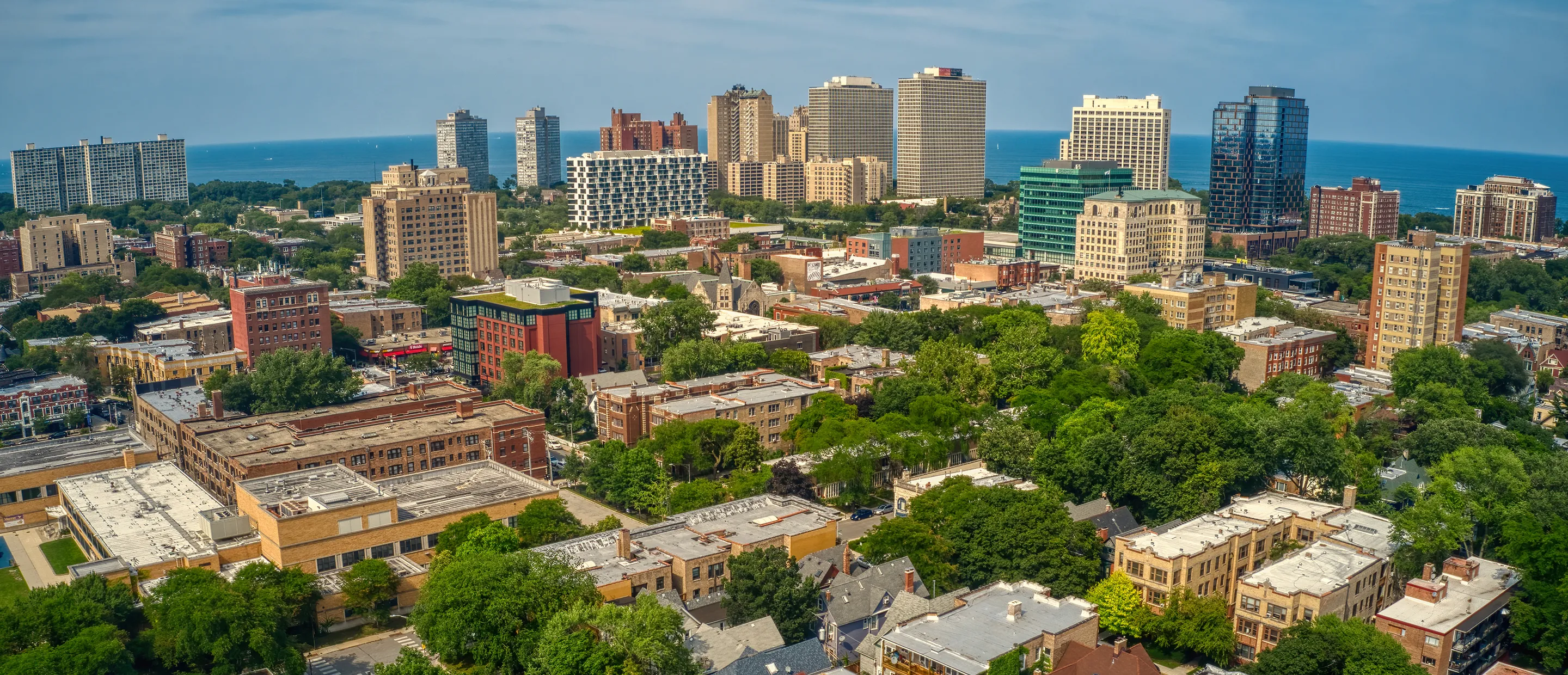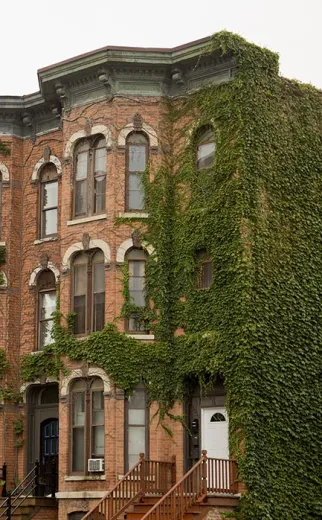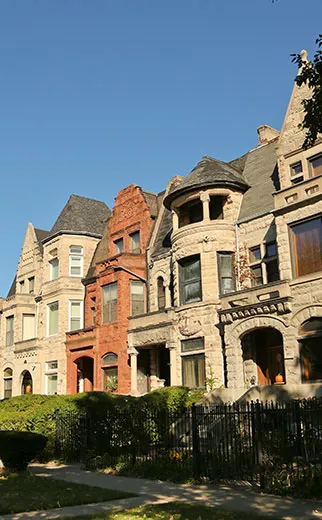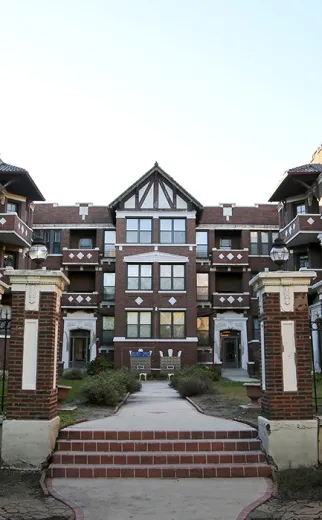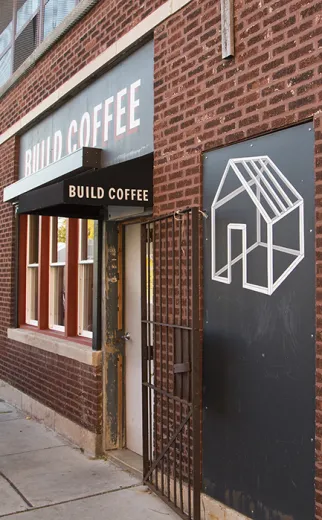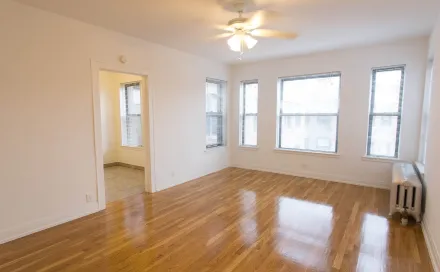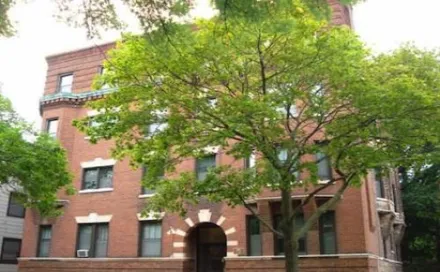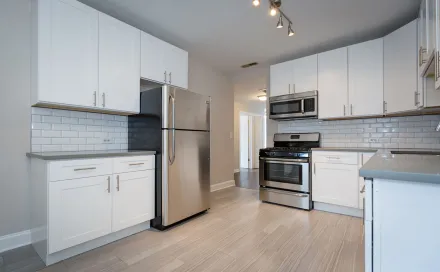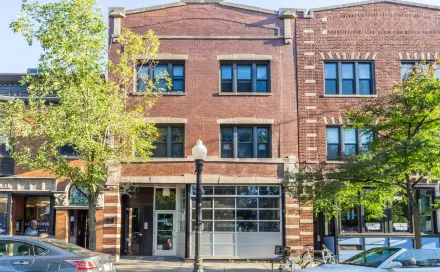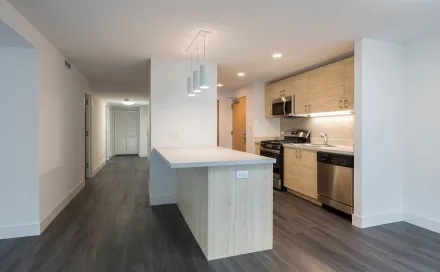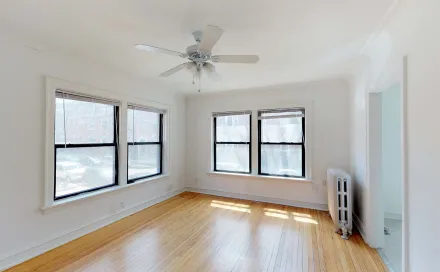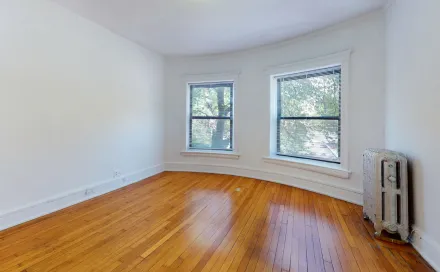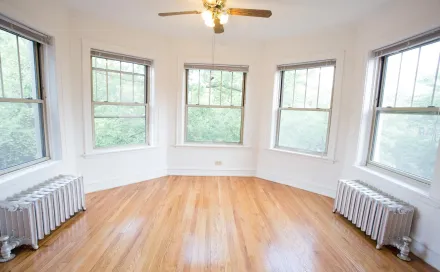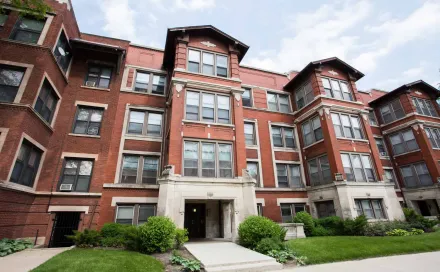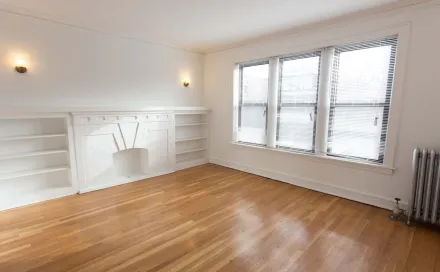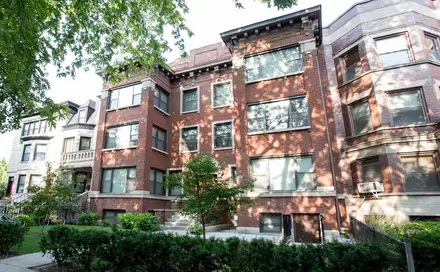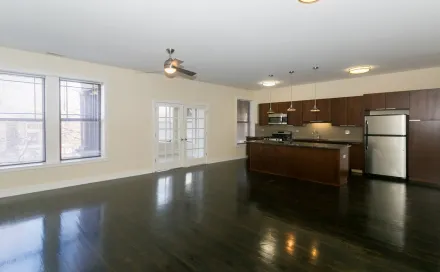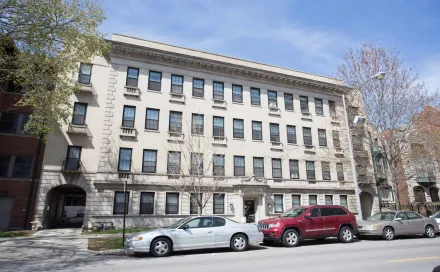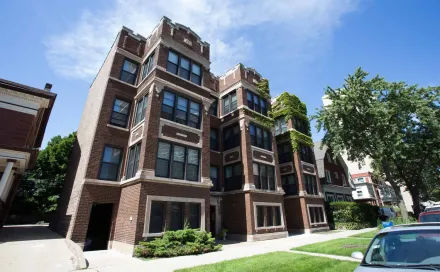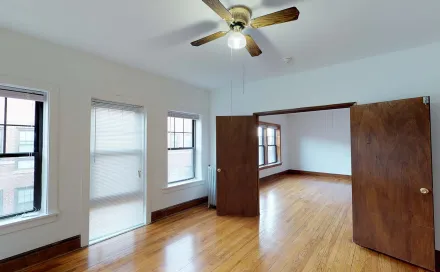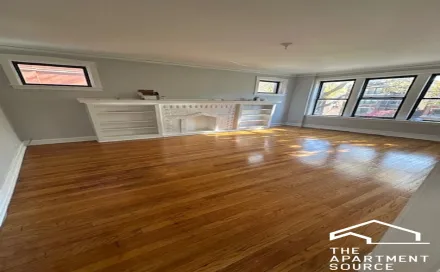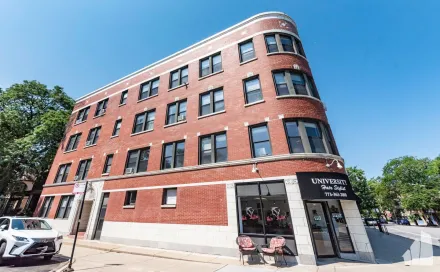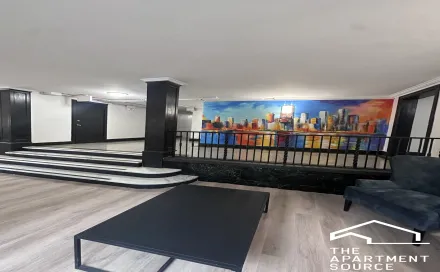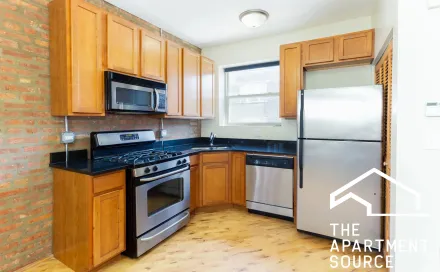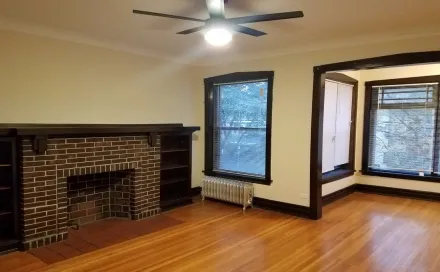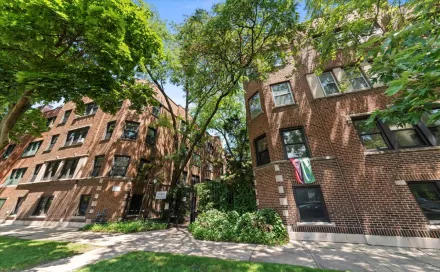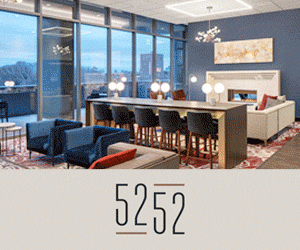Hyde Park Apartment Living
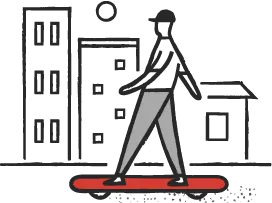
Neighborhood Vibe
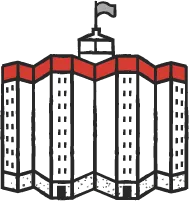
Heart of the Neighborhood
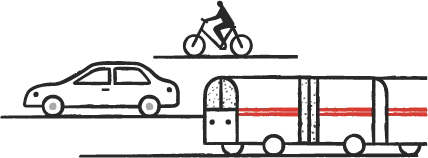
Best Way to Get Around
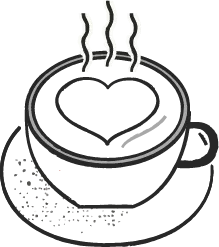
What We Love Most
Find Hyde Park Apartments
| Find Hyde Park Apartments | |
|---|---|
|
Studio in Hyde Park
Average Rent
|
$1.2k-
2.0k
|
|
1 Bedroom in Hyde Park
Average Rent
|
$1.6k-
2.3k
|
|
2 Bedroom in Hyde Park
Average Rent
|
$2.0k-
2.9k
|
|
3 Bedroom in Hyde Park
Average Rent
|
$2.6k-
4.5k
|
|
4+ Bedroom in Hyde Park
Average Rent
|
$3.6k-
4.6k
|
Around the Neighborhood
Overview of Hyde Park
Hyde Park is like Chicago's very own think tank by the lake. It's a place where bookstores outnumber bars, where you're as likely to bump into a Nobel laureate as you are a neighbor walking their dog. But don't let the brainpower intimidate you, this neighborhood has a knack for making high culture feel down to earth.
For apartment renters, Hyde Park is a mosaic of tree-lined residential streets punctuated by pockets of bustling activity. The University of Chicago's gothic spires dominate the skyline, lending an air of Hogwarts-esque magic to the area. But venture beyond the quad, and you'll discover a neighborhood that's far from a one-trick pony.
Take a stroll down 53rd Street, and you'll see Hyde Park's more playful side. Here, vintage record shops sit next to sleek cocktail bars, while food trucks dish out everything from Korean tacos to artisanal ice cream. It's a street that embodies the neighborhood's blend of old-school charm and modern energy.
For nature lovers, Hyde Park is a green oasis in the urban jungle. The lakefront offers miles of jogging and biking trails, while Jackson Park, a remnant of the 1893 World's Fair, provides 500 acres of gardens, lagoons, and even a hidden Japanese island.
Despite the transient student population, there's a foundation of longtime residents who give the neighborhood its soul. They're the ones organizing block parties, tending community gardens, and keeping local institutions like Powell's Books alive and kicking. It’s in this fold that you will be welcomed and, hopefully, become another long-lasting resident.
Hyde Park sits about 7 miles south of downtown Chicago, hugging the shores of Lake Michigan. This historic neighborhood spans from 51st Street to the north, down to 60th Street in the south. To the west, you'll find Washington Park, while the lakefront forms its eastern border. It's a compact area, roughly 1.5 square miles, making it easy to explore on foot or by bike.
Demographics of Hyde Park, Chicago
Hyde Park prides itself on being one of Chicago's most diverse neighborhoods, and the numbers back it up. But what these stats don't capture is the international flavor brought by the university's global student body and faculty.
Age-wise, you've got a bit of everything. There's a solid chunk of 20-somethings thanks to the student population, but also plenty of families and retirees who've called Hyde Park home for decades. The median age hovers around 34, but don't be surprised to find yourself chatting with an 80-year-old professor at the local cafe one day and a group of grad students the next.
Income levels are as varied as the population itself. While the university attracts its fair share of well-heeled academics and professionals, there's also a strong middle-class presence and efforts to maintain affordable housing options.
Education levels in Hyde Park are off the charts, with over 75% of adults holding a bachelor's degree or higher. Despite all the PhDs floating around, pretentiousness is decidedly uncool here.
Weather in Hyde Park, Chicago
Living in Hyde Park means embracing Chicago's famously fickle weather, where it's not entirely uncommon to experience all four seasons in a single week. But hey, it keeps life interesting, right?
Summers are generally warm and pleasant, with temperatures typically ranging from the mid-70s to mid-80s. It's the perfect time to hit the beach at Promontory Point or join the sunbathers in Jackson Park. Just be prepared for the occasional heatwave that can send the mercury soaring into the 90s.
Fall is a local favorite, with crisp temperatures and stunning foliage. It's ideal for long walks through the University of Chicago campus or picnics in Washington Park. Temperatures usually hover between the 50s and 60s, but can dip lower as winter approaches.
Winters are not for the faint of heart. Expect temperatures to drop below freezing from December through February, with January being the coldest month. Snowfall is common, transforming the neighborhood into a winter wonderland, beautiful to look at, less fun to shovel. But Hyde Parkers are a hardy bunch, and you'll still see joggers braving the Lakefront Trail even on the chilliest days.
Spring can be a bit of a tease, with temperatures slowly climbing back up through March and April. It's a time of renewal, when the neighborhood's many gardens burst into bloom and everyone emerges from their winter hibernation.
One thing to note: being right on Lake Michigan can lead to some interesting microclimates. The lake effect can bring sudden temperature changes, fog, or even localized snow. It's all part of the Hyde Park experience! Just remember to always have a light jacket handy, even in summer. After all, as the old Chicago saying goes, "If you don't like the weather, wait five minutes."
Amenities in Hyde Park, Chicago
Local shopping and dining options
Hyde Park's food scene offers something for every palate. For a taste of local history, head to Valois, a cash-only, cafeteria-style diner serving hearty breakfasts since 1921. Medici on 57th, a Hyde Park institution, is known for its burgers, milkshakes, and walls covered in patron graffiti.
For upscale dining, Virtue is making waves with its modern take on Southern cuisine. Craving Italian? Nella Pizza e Pasta serves up authentic Neapolitan-style pies. The Soul Shack offers comfort food with a twist, while Chant brings pan-Asian flavors to the neighborhood.
Caribbean cuisine is well-represented with 14 Parish offering jerk chicken and Ja' Grill Hyde Park has a delicious oxtail stew. For Mediterranean fare, try Ascione Bistro or The Nile for Egyptian specialties.
Coffee lovers have plenty of options. Cafe 53 and Sip & Savor offer great brews and cozy atmospheres. Plein Air Cafe is perfect for studying or working, and for a unique experience, check out Grounds of Being, the "Divinity School Coffee Shop" in the basement of Swift Hall.
Nightlife in Hyde Park
While not known for wild parties, Hyde Park has its share of great spots for a night out. The Promontory offers craft cocktails, live music, and a rooftop bar with skyline views. The Cove Lounge is a classic dive bar serving the neighborhood since the 1930s.
Woodlawn Tap, affectionately known as "Jimmy's" to locals, is where you'll find a mix of students and professors unwinding over pints. Falcon Inn provides a laid-back atmosphere for casual drinks, while Seven Ten Social is all about making friends over a game of bowling or pool.
Entertainment and recreational activities
The historic Harper Theater is a great place to catch a flick, whether it's a new blockbuster or a 90’s indie films. If live action is more your speed, Court Theatre puts on world-class plays and musicals.
For music lovers, Rockefeller Chapel hosts regular concerts. There’s also the annual Hyde Park Jazz Festival, which turns the whole neighborhood into one big jazz club.
If you're the active type, the Lakefront Trail is perfect for getting in a workout. This 18-mile paved path meanders around the shoreline of Lake Michigan and you’ll have breathtaking views of the water and the Chicago skyline. In Hyde Park, you can hop on the trail at several points, including 57th Street Beach or Promontory Point.
For runners, the trail provides a scenic route with mile markers, water fountains, and plenty of fellow joggers to keep you motivated. Cyclists love the dedicated bike lanes, making it easy to cruise along the lakefront or even commute downtown. Rollerbladers and skateboarders also frequent the trail, taking advantage of the smooth pavement and long stretches perfect for building up speed. It’s also a prime spot to meet up with friends, and you'll often see groups power-walking together, families out for a bike ride, or locals walking their dogs. It's especially popular at sunset when the views are at their most spectacular.
For those who prefer their workouts indoors, the University of Chicago's Ratner Athletics Center is a fantastic option. While primarily serving university students and staff, it's also open to the public through membership programs. This state-of-the-art facility offers:
- A 50-meter Olympic-sized swimming pool
- A well-equipped weight room with free weights and machines
- Cardiovascular equipment including treadmills, ellipticals, and stationary bikes
- Multiple basketball and racquetball courts
- An elevated indoor running track
- Group fitness classes ranging from yoga to high-intensity interval training
- A 20-foot climbing wall for bouldering enthusiasts
What sets Ratner apart is its modern design and top-of-the-line equipment. The floor-to-ceiling windows in many areas of the center provide natural light and views of the surrounding campus, making your workout feel less like a chore and more like an enjoyable part of your day.
Parks in Hyde Park, Chicago
Hyde Park is blessed with green spaces. Promontory Point juts out into Lake Michigan, offering amazing city views. Jackson Park, home to the Griffin Museum of Science and Industry, has over 500 acres including the serene Garden of Phoenix, a Japanese-style garden.
57th Street Beach is perfect for summer days, while smaller parks like Harold Washington Playlot Park, Nichols Park, and Spruce Park offer quick escapes. Burnham Park stretches along the lakefront, providing miles of green space and trails.
Stagg Field, named after the legendary football coach Amos Alonzo Stagg, is a hub of athletic activity on the University of Chicago campus. While it's no longer home to the original football stadium where the first controlled nuclear reaction took place (that's now marked by a Henry Moore sculpture), today's Stagg Field has:
- A 400-meter, eight-lane track surrounding an artificial turf field
- Facilities for track and field events, including long jump, high jump, and pole vault areas
- A soccer field that doubles as a space for ultimate frisbee and other field sports
- Bleacher seating for spectators
- Lighting for evening practices and games
Jackman Field, located near the Lab School, is another great spot for sports enthusiasts. It has a more relaxed, community feel compared to Stagg Field. On weekends, you'll often find families picnicking while watching impromptu sports games. It features:
- A well-maintained grass field perfect for pickup soccer games or touch football
- Baseball and softball diamonds
- Open areas ideal for frisbee, kite flying, or simply lounging on a sunny day
Washington Park, while technically just outside Hyde Park's borders, is a huge recreational area that many Hyde Park residents consider part of their extended neighborhood. This 372-acre park offers:
- Baseball and softball fields
- Basketball courts
- Tennis courts
- A gymnasium
- An outdoor pool (open in summer months)
- Large open fields perfect for team sports or casual play
- A 2.33-mile walking/jogging path
Bynum Island, located within Washington Park, is a hidden gem. This small, wooded island sits in the middle of the park's lagoon and is accessible by bridge. The island provides a unique, almost secluded feel despite being in the heart of the city. It's not uncommon to see people reading books or having quiet picnics here, enjoying the tranquil atmosphere. It's a popular spot for:
- Birdwatching (it's on a major migratory path)
- Peaceful walks
- Fishing in the surrounding lagoon
- Photography, especially during the fall foliage season
Whether you're looking to join a pickup game, train for a marathon, or simply find a peaceful spot to relax outdoors, these fields and parks offer something for everyone.
Museums in Hyde Park, Chicago
Hyde Park has a great collection of museums, more than enough to fill up a few weekends!
The Smart Museum of Art, part of the University of Chicago, is a spot that often flies under the radar. Its collection spans 5,000 years of human creativity, from ancient Chinese ceramics to contemporary American paintings. Some highlights include:
- A significant collection of Old Master paintings
- An extensive array of modern and contemporary art, including works by Rothko and Warhol
- A sculpture garden featuring works by Rodin and Moore
- Rotating special exhibitions that often challenge conventional art narratives
The Smart Museum is known for its innovative approach to curation, often juxtaposing works from different periods and cultures to create thought-provoking dialogues. It's free to the public and offers guided tours that provide fascinating insights into the collections.
The Institute for the Study of Ancient Cultures is a time machine that transports you to the ancient Middle East. Founded in 1919, it houses an incredible collection of artifacts from ancient Egypt, Mesopotamia, Persia, and other early civilizations. Don't miss:
- The colossal 40-ton human-headed winged bull from Khorsabad
- The 17-foot-tall statue of King Tut
- An extensive collection of cuneiform tablets
- A recreation of an ancient Egyptian tomb
The Institute is also an active research center. Visitors can often observe archaeologists and researchers at work, providing a unique behind-the-scenes look at how we uncover and interpret the past.
The DuSable Museum of African American History, located on the edge of Washington Park, is the oldest independent African American museum in the country. It offers a comprehensive look at African American history and culture, from pre-colonial Africa to the present day. Key exhibits include:
- "Freedom, Resistance and the Journey Toward Equality," a powerful exploration of the African American experience
- The Harold Washington Archives, dedicated to Chicago's first African American mayor
- A collection of African American art spanning several centuries
The museum regularly hosts lectures, film screenings, and cultural events, making it a vibrant community hub as well as a repository of history.
The Hyde Park Art Center is a dynamic space that bridges the gap between emerging artists and the community. More than a gallery, it’s also a school and community center. Here you'll find:
- Exhibitions featuring cutting-edge work by Chicago artists
- Art classes and workshops for all ages and skill levels
- Artist talks and open studios
- The Jackman Goldwasser Residency program, which brings international artists to work in Chicago
The Art Center is known for its accessibility and its commitment to making contemporary art approachable and engaging for everyone.
Finally, there's The Griffin Museum of Science and Industry. Housed in the Palace of Fine Arts, the last remaining building from the 1893 World's Columbian Exposition, it's the largest science museum in the Western Hemisphere. Some of its most popular exhibits include:
- A full-size replica coal mine
- The U-505 submarine, captured during World War II
- The Pioneer Zephyr, a diesel-electric train from the 1930s
- A 13-foot-tall human heart model you can walk through
- The "Science Storms" exhibit, which lets you experience the power of natural phenomena
The museum is famous for its hands-on, interactive approach to science education. It's not uncommon to see adults getting just as excited as children while conducting experiments or exploring the exhibits.
What makes Hyde Park's museum scene truly special is its accessibility. Many of these institutions offer free or discounted admission to local residents. The Smart Museum is always free, while the The Institute for the Study of Ancient Cultures and Hyde Park Art Center suggest a donation but don't require an entrance fee. The DuSable Museum and the Museum of Science and Industry offer free days throughout the year, often coordinated with Chicago Public Schools' days off. These museums frequently collaborate with local schools and community organizations, bringing their resources directly into the neighborhood through outreach programs and special events.
Whether you're a lifelong learner, a casual visitor, or a family looking for an educational day out, Hyde Park's museums offer a world of discovery right in your backyard.
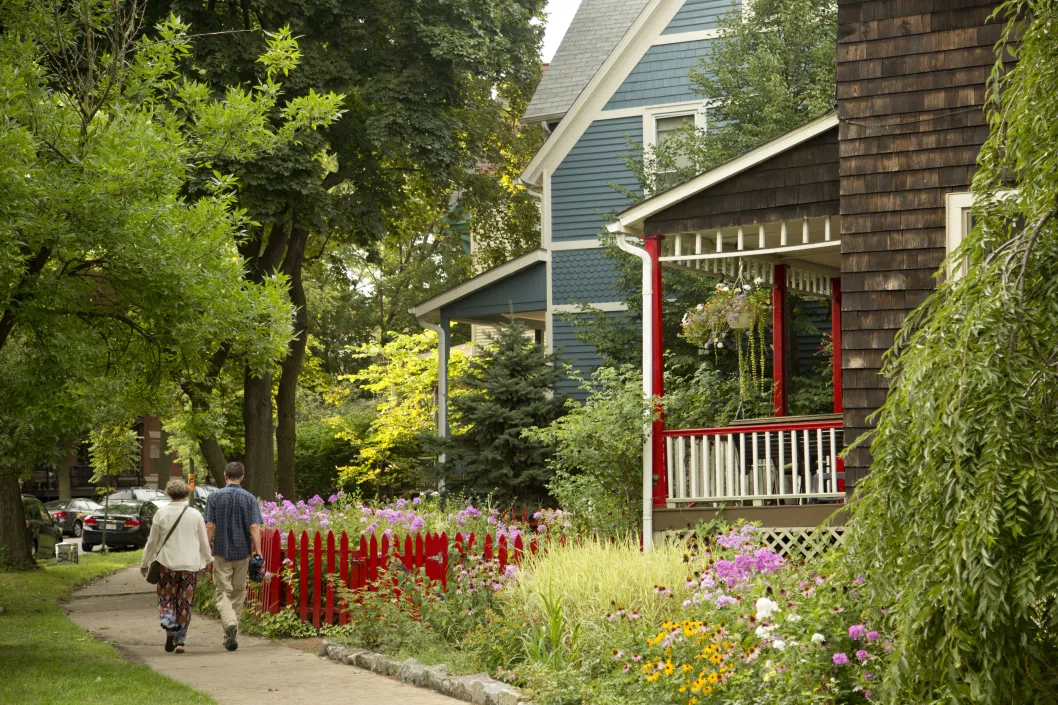
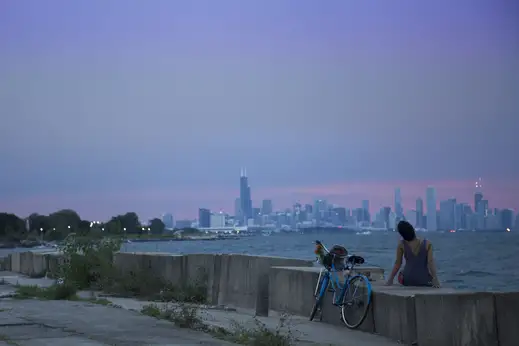
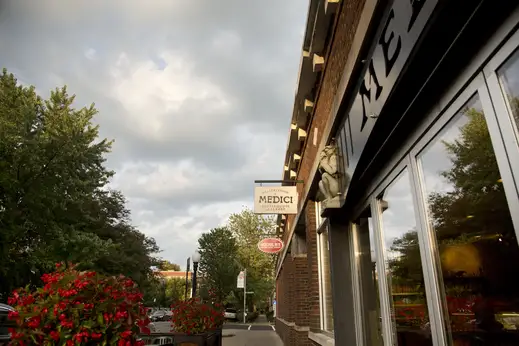
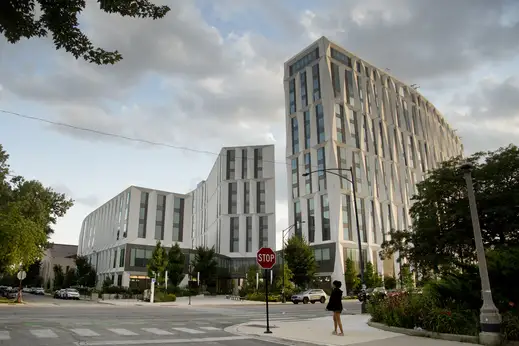
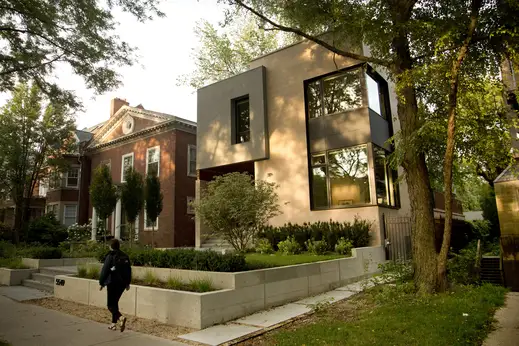

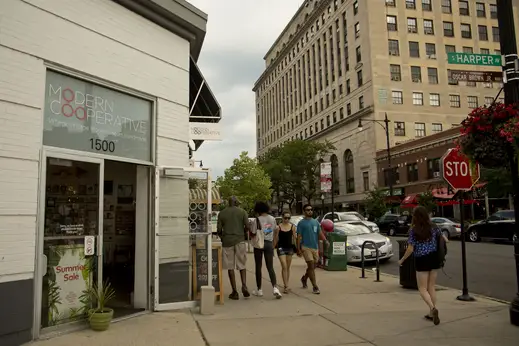
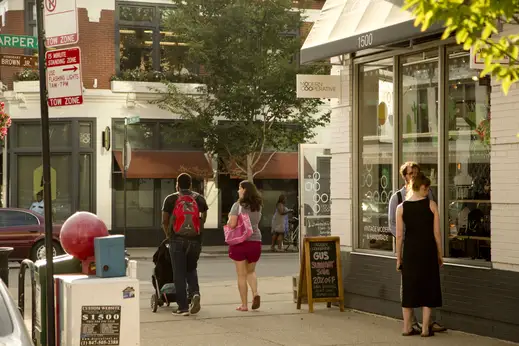
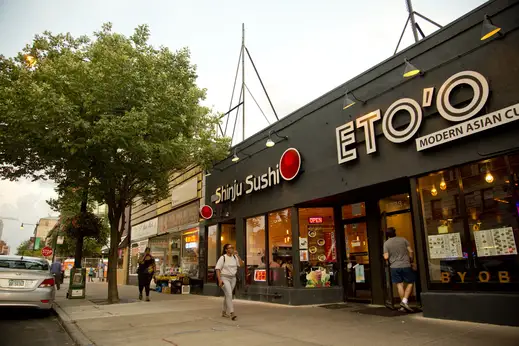
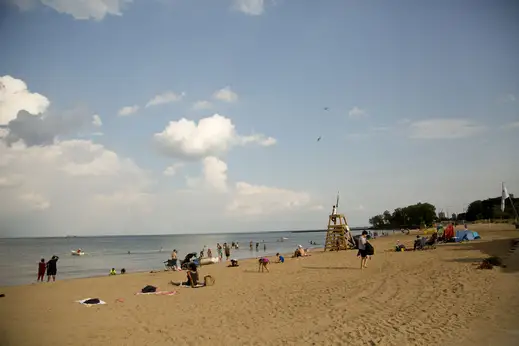

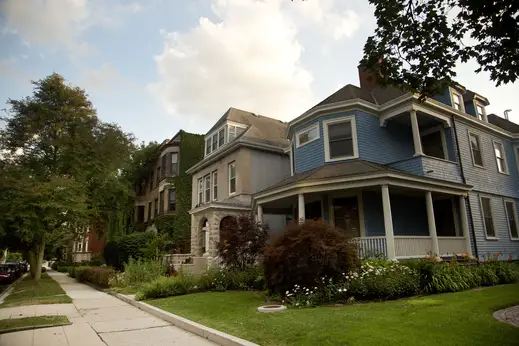
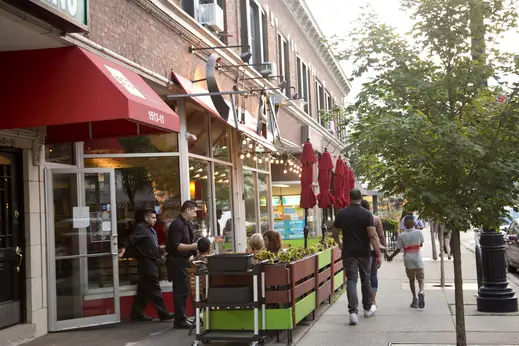
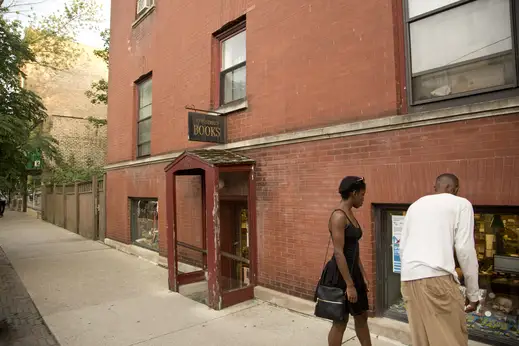
Transportation in Hyde Park
Hyde Park's transportation options offer a blend of convenience and variety, making it easy for residents to navigate both the neighborhood and the wider city. Whether you're commuting to work, heading downtown for a night out, or exploring Chicago's many attractions, you'll find multiple ways to get where you need to go.
Access to highways
While Hyde Park isn't directly on a major highway, it's well-connected to Chicago's road network. Lake Shore Drive (US-41) runs along the neighborhood's eastern edge, providing quick north-south access along the lakefront. To reach I-90/94 (Dan Ryan Expressway):
Take 55th Street West to the Dan Ryan, about a 10-minute drive in light traffic Alternatively, use 51st Street for a slightly quicker route
For those heading south or to Indiana, I-90 (Chicago Skyway) is accessible via Stony Island Avenue, about a 5-minute drive from central Hyde Park.
CTA Bus Routes in Hyde Park
The Chicago Transit Authority (CTA) operates several bus routes serving Hyde Park, making it easy to get around without a car:
- #2 Hyde Park Express: Connects to downtown during rush hours
- #4 Cottage Grove: North-south route along Cottage Grove Avenue
- #6 Jackson Park Express: Runs along Lake Shore Drive to downtown
- #15 Jeffery Local: Serves 51st Street and Lake Park Avenue
- #28 Stony Island: North-south route on Stony Island Avenue
- #55 Garfield: East-west route along 55th Street
- #171 University of Chicago/Hyde Park: Circular route within Hyde Park
- #172 University of Chicago/Kenwood: Connects Hyde Park to Kenwood
These buses connect to various CTA 'L' train lines, expanding your reach throughout the city. Real-time bus tracking is available through CTA's website and mobile apps.
Metra Train Stops in Hyde Park
Hyde Park is served by Metra's Electric Line, offering quick access to downtown and the South Side. Stations in Hyde Park include:
- 51st/53rd Street (Hyde Park)
- 55th-56th-57th Street
- 59th Street (University of Chicago)
The Metra Electric Line runs frequently during rush hours (every 10-20 minutes) and provides service throughout the day and on weekends. The ride to downtown's Millennium Station takes about 15-25 minutes, depending on your departure point in Hyde Park.
Distance to downtown and other notable locations
Hyde Park's location offers a balance between urban accessibility and residential calm. Here are approximate travel times to key destinations:
- Downtown Chicago (The Loop): 15-25 minutes by Metra, 20-30 minutes by car (traffic-dependent)
- O'Hare International Airport: 45-60 minutes by car, 75-90 minutes by public transit
- Midway Airport: 25-35 minutes by car, 45-60 minutes by public transit
- University of Chicago: Within Hyde Park, walkable or a short bus ride from most locations
- Griffin Museum of Science and Industry: Located in Hyde Park, easily accessible by foot or bus
- Magnificent Mile: 25-35 minutes by car, 30-40 minutes by public transit
- Soldier Field: 15-20 minutes by car, 25-35 minutes by public transit
- Millennium Park: 20-30 minutes by car, 25-35 minutes by Metra or bus
- Navy Pier: 25-35 minutes by car, 40-50 minutes by public transit
- United Center: 25-35 minutes by car, 45-55 minutes by public transit
- Lincoln Park Zoo: 30-40 minutes by car, 50-60 minutes by public transit
- Wrigley Field: 35-45 minutes by car, 55-65 minutes by public transit
These times are approximate and can vary depending on traffic conditions, time of day, and specific starting point within Hyde Park. Public transit times may also vary based on train or bus schedules and any necessary transfers.
Parking options and availability
Parking in Hyde Park can be challenging, but not impossible. Here's what you need to know:
- Street parking: Many residential streets have permit parking. Visitors can purchase daily passes online or at local currency exchanges.
- Metered parking: Available in commercial areas, particularly along 53rd Street and Lake Park Avenue. Use the ParkChicago app for easy payment.
- Parking garages: Several public lots and garages are available, including:
- East 55th Street Garage (managed by SP+)
- Campus North Parking Garage (at the University of Chicago)
- Ellis Parking Garage (also at the University)
- University of Chicago parking: The university offers various parking options for students, staff, and visitors. Check their transportation services website for details.
Remember that snow parking bans are enforced on major streets during winter months, so always check signs carefully.
For residents, some apartment buildings offer dedicated parking, but it often comes at an additional cost. If you're apartment hunting and own a car, be sure to inquire about parking options.
Schools and Higher Learning Institutions in Hyde Park
Public, private, and charter school options
Hyde Park is part of Chicago Public Schools (CPS) District 299, so if you've got kids (or are planning to), you're in for a treat. From public to private, this neighborhood has education down to a science (and art, and literature...). Let's take a stroll through the academic playground that makes Hyde Park a top choice for families:
- University of Chicago Laboratory Schools (Nursery-12): Founded by John Dewey, "Lab" is consistently ranked among the top private schools in the nation, offering a progressive education model with strong ties to the University of Chicago.
- Ray Elementary School (K-8): A Chicago Public School known for its diverse student body, strong focus on arts integration, and social-emotional learning. It has an active parent community.
- Bret Harte Elementary School (K-8): A Chicago Public School offering a well-rounded curriculum with an emphasis on technology and STEM education. The school features a garden program that integrates science and nutrition education.
- Kenwood Academy High School (7-12): One of Chicago's top-performing public high schools, offering a rigorous academic program including Advanced Placement courses and a renowned arts program.
- William H. Shoesmith Elementary School (K-6): A Chicago Public School known for its strong literacy program and community partnerships, providing a nurturing environment for early learners.
- Akiba-Schechter Jewish Day School (Preschool-8): A private school providing a dual curriculum of general and Judaic studies, emphasizing critical thinking and individualized attention.
- Chicago Free School (K-12): A private school offering a democratic education model where students have a voice in their learning and school governance.
- Walter H. Dyett High School for the Arts: This Chicago Public high school is where budding artists come to hone their craft and unleash their creativity across various disciplines.
- Kozminski Community Academy (K-8): Kozminski offers Hyde Park kids a solid foundation with a strong emphasis on community involvement.
- Murray Language Academy (K-8): At Murray, kids don't just learn subjects - they learn languages to talk about those subjects, setting them up for a global future. •
- Phillip Murray Elementary Language Academy: This elementary school takes language learning seriously, giving kids a head start in our increasingly connected world.
- University of Chicago Charter School Woodlawn Campus (6-12): UChicago's educational magic doesn't stop at college - their charter school brings that same academic rigor to middle and high schoolers.
University, college, and others higher learning institution options
Whether you're looking to earn a degree, attend a mind-bending lecture, or just soak up the academic atmosphere, this neighborhood has plenty of higher-education options to choose between. From groundbreaking research to soul-searching theology, Hyde Park's higher ed scene is like an all-you-can-eat buffet for the mind. Check out these intellectual heavyweights:
- University of Chicago: Welcome to the big leagues, folks. UChicago is an intellectual powerhouse that's been shaping minds (and collecting Nobel Prizes) since 1890. It's consistently ranked among the world's top universities, and for good reason. UChicago is where fun goes to get serious, and serious goes to have fun. From economics to astrophysics, they've got it all:
- Pritzker School of Medicine
- Booth School of Business
- University of Chicago Law School
- School of Social Service Administration
- Harris School of Public Policy
- Divinity School
- Graham School of Continuing Liberal and Professional Studies
- Pritzker School of Molecular Engineering
- Catholic Theological Union: The largest Roman Catholic graduate school of theology and ministry in North America, it has a diverse student body and a real knack for crossing cultural boundaries.
- Chicago Theological Seminary: If you're into progressive theology with a side of social justice, this United Church of Christ seminary is your jam. They're all about preparing faith leaders who aren't afraid to shake things up. From ministry to activism, they've got programs that'll make you think twice about what religion can do in the modern world.
- McCormick Theological Seminary: Presbyterian? Check. Forward-thinking? Double-check. This graduate school is where future ministers, community leaders, and deep thinkers come to wrestle with big ideas. Whether you're eyeing a master's or a doctorate, they've got the theological tools to help you make a difference.
- Toyota Technological Institute at Chicago: Don't let the name fool you, we're not talking cars here. This is where computer science gets serious. It's a small but mighty graduate institute that's practically joined at the hip with UChicago. If you're into pushing the boundaries of tech and AI, this place will be your digital playground.
Real Estate in Hyde Park, Chicago
Overview of the real estate market
Hyde Park's real estate landscape defies easy categorization. This South Side neighborhood packs heavy-hitting architecture into its relatively compact footprint. Victorian mansions rub shoulders with mid-century apartment blocks, while gleaming new developments add a contemporary edge.
The market here is heating up, but it's not quite at a full boil. It’s a sweet spot where the University of Chicago's gravitational pull meets the allure of lakefront living and the result is a neighborhood that attracts everyone. From wide-eyed freshmen to emeritus professors and young families to long-time Chicagoans looking for a change of pace.
Rental rates and popular housing styles
Whether you're hunting for affordable Hyde Park apartments near University of Chicago or dreaming of luxury lakefront rentals, Domu's got your back. Let's break down what you can expect in your Hyde Park apartment search:
Studios and One-Bedrooms: For those flying solo or couples who like their space, Hyde Park's got plenty of options. Studio apartments in Hyde Park typically range from $1,200 to $2,000, while one-bedroom Hyde Park rentals usually fall between $1,600 and $2,500. Many of these cozy spots are perfect for University of Chicago off-campus housing options, putting you just a short stroll from campus.
Family-Friendly Finds: Looking for the best Hyde Park neighborhoods for families? You're in luck. Two-bedroom apartments in Hyde Park generally go for $2,000 to $2,900, while three-bedroom apartments range from $2,600 to $4,500+.
Apartment Features to Look For: When browsing Hyde Park Chicago apartments on Domu, keep an eye out for these popular amenities:
- Hardwood floors (a common find in vintage buildings)
- Updated kitchens (especially in newer developments)
- Air conditioning (a must for those humid Chicago summers)
- On-site laundry or in-unit washers and dryers
- Pet-friendly policies (for your furry roommates)
Rental rates in Hyde Park are highly dependent on the type of building, amenities, and time of year you are moving in. Before starting your search, take a look at Domu’s Rent Calculator and our article on expected costs to rent an apartment in Chicago to learn more about what you can afford and the expenses that go beyond monthly rent.
Popular Apartment Buildings in Hyde Park, Chicago
While searching on Domu, you might spot these popular buildings:
- Regents Park Apartments
- Twin Towers Apartments
- The Flamingo Apartments
- 5550 S Dorchester Apartments
- Algonquin Apartments
- The Versailles Apartments
- The Mayfair Apartments
- 5252 Apartments
- Shoreland Apartments
- Sutherland Apartments
- Solstice Apartments
- East Park Tower Apartments
Rental properties in Hyde Park can move quickly, especially during peak moving seasons (typically May through September). Our guide on Moving to Chicago will help you prepare and be ready to jump the moment you see the apartment of your dreams.
Future Development in Hyde Park Chicago
Set to open in 2025, the Obama Presidential Center will bring a new chapter of history to the Hyde Park neighborhood. The Obama Presidential Center will be located in Jackson Park adjacent to the University of Chicago and will draw visitors from around the world.
At 5209 S Harper Avenue, further development for Harper Court is underway. This phase of the project will bring a new low-rise building, replacing a former one-story structure. The construction will expand retail space and create new office and lab space. As new residential buildings in Hyde Park, Chicago are completed, check Domu listings for more information on how to be one of the first residents.
Conclusion
While the proximity to the University of Chicago is a major draw, Hyde Park's appeal extends far beyond academia. The neighborhood's many offerings, from museums and theaters to bookstores and cafes, will keep your calendars packed and a smile on your face. The abundance of green spaces and lakefront access provides a welcome respite from city life, where you can spend the morning shopping downtown and the evening resting under a huge tree in a park.
For apartment renters, Hyde Park has so much to offer. Whether you're a student looking for a cozy studio, a young professional seeking a luxury apartment with amenities, or a family in need of renting a spacious house, you'll find it here. The neighborhood's mix of vintage charm and contemporary developments means you can choose a living space that really suits your style and budget.
Ready to make your Chicago apartment-hunting dreams come true? Head over to our Hyde Park listings page to find your perfect apartment. But don't wait too long—the best spots in this vibrant neighborhood go fast! Start your search with Domu today, and before you know it, you'll be browsing the shelves at 57th Street Books or enjoying a picnic at Promontory Point. Your new Hyde Park home is waiting for you!
History of Hyde Park, Chicago
Hyde Park's story is a fascinating journey through Chicago's past, peppered with big names and even bigger ideas. This neighborhood wasn't always part of the bustling city; it started as a sleepy suburb in the 1850s, dreamed up by a savvy real estate developer named Paul Cornell. He saw potential in the lakeside location and convinced the Illinois Central Railroad to make a stop here. Smart move, Paul.
The area really hit its stride when it was chosen as the site for the World's Columbian Exposition in 1893. This was a spectacle that put Chicago on the global map. The "White City," as it was called, showcased cutting-edge architecture and technology. While most of the grand buildings are long gone, you can still catch a glimpse of that bygone era at the Griffin Museum of Science and Industry, originally the fair's Palace of Fine Arts.
Around the same time, a little institution called the University of Chicago set up shop, thanks to some deep pockets from John D. Rockefeller. The university quickly became a powerhouse, attracting brilliant minds from around the world. It's been shaping the neighborhood's character ever since, infusing Hyde Park with an intellectual energy that's hard to miss.
Fast forward to the mid-20th century, and Hyde Park was making waves again. While many urban areas struggled with racial tensions, Hyde Park embraced integration, becoming one of the first stable, racially mixed communities in the nation. This progressive spirit attracted residents like a young Barack Obama, who taught at the University of Chicago Law School and started his political career here.
Today, Hyde Park wears its history proudly. You'll see it in the grand old homes along Kenwood Avenue, in the time-worn benches of Promontory Point, and in the spirited discussions at the Seminary Co-op Bookstore.
For apartment hunters, this rich history translates into a neighborhood with serious character. You might find yourself renting in a vintage courtyard building from the 1920s, complete with art deco details and squeaky hardwood floors. Or maybe you'll opt for a sleek new high-rise with views of the lake that the World's Fair visitors could only dream of. Either way, when you move to Hyde Park, you're becoming part of a story that's been unfolding for over 150 years.

